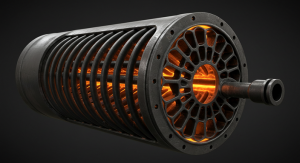A tubular heat exchanger serves as a critical component in various industries, including oil and gas, chemical processing, power generation, food processing, and HVAC systems. It efficiently transfers heat from one fluid to another without mixing the two, making it essential for controlled thermal exchange processes.
This type of heat exchanger consists of a series of tubes, where one set carries the hot fluid and the other contains the cold fluid. The heat transfers through the tube walls, allowing energy to pass from the hotter medium to the cooler one. Engineers choose tubular heat exchangers for their durability, flexibility, and excellent thermal performance.
The design allows for a high level of customization. Depending on specific industry requirements, you can modify tube materials, size, layout, and number of passes. These design variations help optimize performance, minimize pressure drop, and improve energy efficiency. Their adaptability also supports operation in extreme pressure and temperature conditions.
Stainless steel, titanium, and copper alloys are common materials used to manufacture the tubes. Each material offers specific benefits depending on the operating environment. For example, stainless steel resists corrosion and oxidation, making it suitable for chemical and food processing applications.
Cleaning and maintenance play an important role in extending the life of tubular heat exchangers. Their structure permits mechanical cleaning and chemical flushing, which simplifies the removal of deposits and fouling that reduce thermal performance over time. Proper maintenance ensures efficiency and prevents costly downtime.
A major advantage of the tubular heat exchanger lies in its scalability. Whether handling small process flows in a laboratory or massive volumes in industrial plants, this heat exchanger accommodates diverse requirements. It supports parallel or series installation, depending on the flow configuration and temperature profiles.
The two main configurations include single-pass and multi-pass designs. A single-pass heat exchanger allows fluid to travel through the length of the tube bundle once, while a multi-pass setup lets the fluid change direction multiple times. The latter provides higher heat transfer efficiency and is often used in high-performance systems.
In addition, engineers can choose between co-current and counter-current flow designs. In co-current flow, both fluids move in the same direction. In counter-current flow, fluids move in opposite directions, offering improved thermal efficiency and higher outlet temperature differences.
Safety is another critical consideration in heat exchanger design. Tubular designs help prevent fluid leakage by ensuring proper sealing and separation. This feature proves particularly valuable in industries where contamination or hazardous fluid mixing could lead to operational risks or health concerns.
From an environmental perspective, tubular heat exchangers support energy conservation and waste heat recovery. Reclaiming energy that would otherwise be lost enhances sustainability and lowers operational costs. Many companies use these systems as part of their energy efficiency and green technology initiatives.
Computational modeling and fluid dynamic analysis help optimize new designs. Engineers use software tools to simulate fluid behavior, temperature gradients, and pressure variations. These simulations contribute to more accurate performance predictions and better design decisions.
Choosing the right tubular heat exchanger involves assessing multiple factors, including fluid properties, flow rates, pressure requirements, and space constraints. Partnering with experienced manufacturers and suppliers ensures you get a product tailored to your specific application needs.
For businesses seeking reliable and custom-engineered solutions, tubular heat exchanger products from trusted industry players offer dependable performance and long service life.
Proper installation also plays a vital role in the efficiency and longevity of the system. Installers must ensure correct alignment, secure connections, and optimal insulation. Poor installation can lead to leaks, reduced thermal transfer, and premature equipment failure.
Over time, operating conditions such as fluid velocity, fouling tendencies, and temperature extremes can affect heat exchanger performance. Implementing monitoring systems helps track these factors and predict when maintenance or component replacement is necessary.
While initial investments in tubular heat exchangers can be higher than other types, the return on investment proves significant over time. These systems often outperform alternatives in terms of durability, efficiency, and maintenance costs.
Advanced manufacturing techniques, such as precision welding and automated tube expansion, improve product reliability and performance. Modern fabrication methods also allow for faster production times and better quality control.
Technological innovations continue to enhance tubular heat exchanger performance. New coatings, improved tube geometries, and nanotechnology-based materials reduce fouling, increase thermal conductivity, and extend equipment life. Research and development efforts ensure that these devices remain integral to industrial thermal systems.
Finally, the global market for tubular heat exchangers continues to grow. Demand rises due to the expansion of energy, chemical, and manufacturing sectors. Companies that invest in energy efficiency and environmental compliance contribute further to this upward trend.
FAQs About Tubular Heat Exchanger
What is a tubular heat exchanger?
A tubular heat exchanger is a device that transfers heat between two fluids using a set of tubes. It allows thermal energy to pass from a hot fluid to a cold fluid without mixing them.
What industries use tubular heat exchangers?
Industries such as oil and gas, power generation, chemical processing, food and beverage, and HVAC commonly use tubular heat exchangers for efficient thermal management.
How do I maintain a tubular heat exchanger?
Regular cleaning, either mechanically or chemically, is essential. Monitoring for fouling and pressure drops also helps maintain efficiency and extend the life of the unit.
Why choose a tubular heat exchanger over other types?
Tubular heat exchangers offer superior durability, are easier to clean, support high pressure and temperature applications, and provide customizable configurations for various industrial needs.
What materials are used in tubular heat exchangers?
Common materials include stainless steel, copper alloys, and titanium, depending on corrosion resistance, thermal conductivity, and the nature of the fluids involved.
